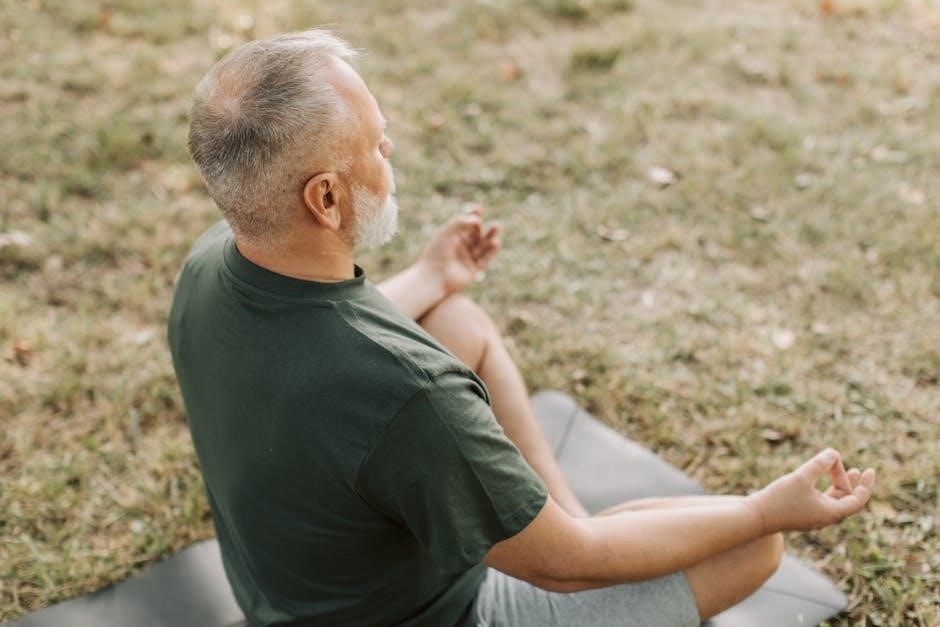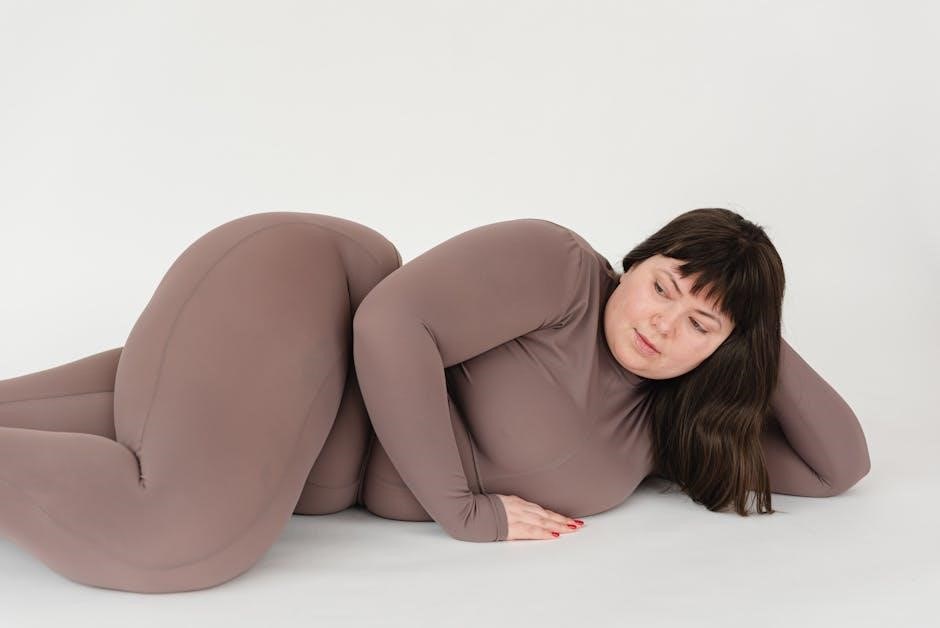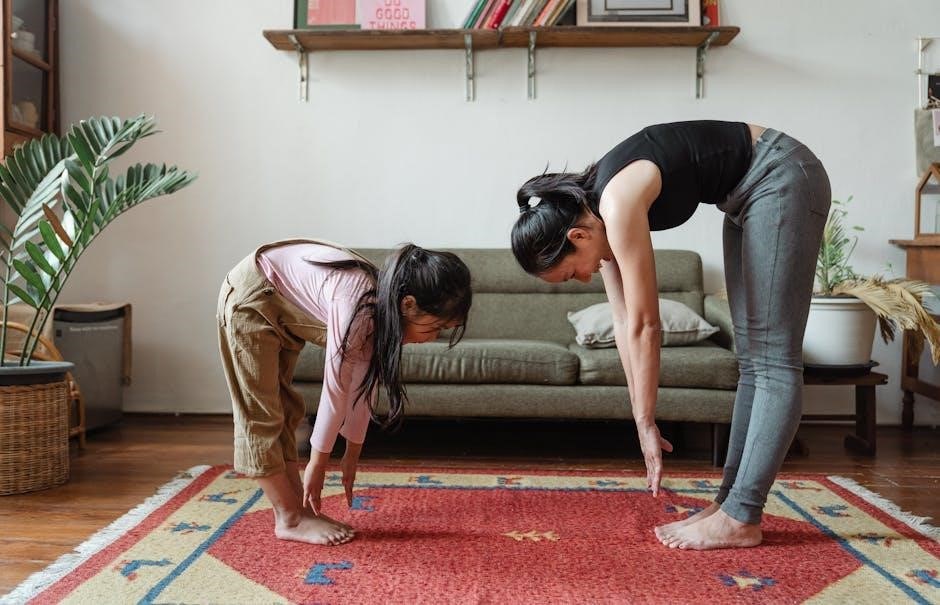Postural drainage is a technique using gravity to clear lung secretions by positioning patients to facilitate mucus movement. It enhances respiratory health and aids in managing conditions like cystic fibrosis.
1.1 Definition and Purpose
Postural drainage is a therapeutic technique that uses gravity to assist in clearing mucus from specific lung segments by positioning the body to facilitate secretion movement. The primary purpose is to enhance mucus clearance, improving respiratory function and reducing the risk of infections. It is commonly used in conditions like cystic fibrosis and COPD. By strategically positioning patients, gravity helps guide secretions toward the central airways, making them easier to cough up. This method is a cornerstone of respiratory physiotherapy, aiming to optimize lung health and prevent complications.

1.2 Historical Background
Postural drainage has its roots in early respiratory therapies, emerging as a structured technique in the mid-20th century. Initially developed to aid patients with tuberculosis, it evolved to address various respiratory conditions. The method gained prominence in the 1950s and 1960s as physiotherapists refined positioning strategies to optimize mucus clearance. Its effectiveness in managing cystic fibrosis and COPD solidified its place in respiratory care. Over time, advancements in understanding lung anatomy and secretion dynamics have further refined postural drainage techniques, making it a cornerstone of modern respiratory physiotherapy.
1.3 Importance in Respiratory Care
Postural drainage is a cornerstone in respiratory care, offering a non-invasive method to enhance mucus clearance and improve lung function. By leveraging gravity, it aids in mobilizing secretions, reducing the risk of infections and complications. This technique is particularly vital for patients with chronic conditions like cystic fibrosis and COPD, where persistent mucus buildup can lead to severe respiratory issues. Its effectiveness in preventing pulmonary infections and promoting airflow makes it a critical component of both acute and long-term respiratory management, enhancing quality of life and reducing healthcare burden.

Techniques and Methods
Postural drainage employs various techniques like positioning, breathing exercises, and manual methods to enhance mucus clearance, improving respiratory function and patient comfort effectively in clinical settings.
2.1 Manual Techniques: Percussion, Vibration, and Shaking
Manual techniques such as percussion, vibration, and shaking are integral to postural drainage, aiding in mucus mobilization. Percussion involves rhythmic clapping on the chest, while vibration uses oscillations during exhalation. Shaking gently moves the torso to dislodge secretions. These methods enhance lung clearance, improving ventilation and reducing obstruction. They are particularly effective for patients with chronic respiratory conditions, promoting easier expectoration. Proper technique is essential to avoid discomfort or injury, ensuring safe and effective treatment. Regular application can significantly improve respiratory function and overall patient well-being.
2.2 Breathing Techniques: Active Cycle of Breathing (ACB)
The Active Cycle of Breathing (ACB) is a valuable respiratory technique that enhances mucus clearance. It involves three phases: deep inhalation to fill the lungs, a brief breath-hold to allow air penetration, and a forced exhalation to expel secretions. This method, often used in conjunction with postural drainage positions, improves lung function and reduces obstruction. ACB is particularly effective for individuals with chronic respiratory conditions, promoting easier expectoration. Proper technique is essential for maximizing benefits and ensuring patient safety and comfort.
2.3 Role of Gravity in Drainage

Gravity plays a crucial role in postural drainage by assisting in the movement of mucus from specific lung segments to the central airways. By positioning the patient in a way that targets the affected areas, mucus is more easily mobilized and cleared. This technique leverages the body’s natural orientation to enhance drainage efficiency. Proper alignment ensures that secretions flow toward the trachea, facilitating coughing or expectation. The strategic use of gravity makes postural drainage a highly effective method for managing respiratory conditions and improving lung health.

Positions for Postural Drainage
Postural drainage uses specific positions to target different lung segments, enhancing mucus clearance. Each position is designed to use gravity effectively, aiding in secretion movement and improve respiratory function.
3.1 Positions for Upper Lung Segments (Apical)
Postural drainage for upper lung segments focuses on apical regions. Positions include head-down tilt or side-lying with chest elevated. These postures use gravity to mobilize mucus from upper lobes, improving clearance and reducing stagnation. Techniques often involve placing the patient at a 30-45 degree angle, ensuring mucus flows toward central airways. This enhances expectoration and prevents retention, particularly beneficial for conditions like cystic fibrosis. Proper alignment and support are crucial to maximize drainage efficiency and patient comfort during therapy sessions.
3.2 Positions for Middle Lung Segments (Posterior)
Postural drainage for middle lung segments targets the posterior regions. Common positions include prone or side-lying with the chest slightly elevated. These postures facilitate mucus drainage from the posterior lobes by leveraging gravity. Patients may also sit upright with a forward lean to enhance clearance. Gentle manual techniques, like percussion or vibration, can be applied to improve mobilization. These positions are particularly effective for conditions like COPD and bronchiectasis, reducing mucus retention and promoting easier expectoration. Proper positioning ensures optimal drainage and comfort, making it a key component of respiratory therapy plans.
3.3 Positions for Lower Lung Segments (Anterior)
For lower lung segments (anterior), postural drainage positions often involve lying supine with the head slightly elevated or in a semi-recumbent position. This allows gravity to assist in draining mucus from the anterior regions. Another effective position is the prone lie with the head turned to the side, which helps mobilize secretions. Additionally, sitting upright with legs extended or using a coughing position can enhance clearance. These postures are particularly beneficial for patients with conditions like cystic fibrosis or COPD, as they promote effective mucus evacuation and improve respiratory function. Regular practice ensures better lung health and reduces complications.
Benefits and Efficacy
Postural drainage enhances mucus clearance, reduces infection risk, and improves lung function, leading to better respiratory health and fewer complications in chronic conditions.
4.1 Improved Mucus Clearance
Postural drainage significantly enhances mucus clearance by leveraging gravity to guide secretions toward the central airways, where they can be coughed up more effectively. This technique, often combined with manual methods like percussion and vibration, helps break down thick mucus, making it easier to expel. Regular use of postural drainage positions can reduce the viscosity of mucus and prevent its retention, which is particularly beneficial for individuals with conditions like cystic fibrosis or COPD. Improved mucus clearance leads to reduced coughing, better lung function, and a lower risk of respiratory infections.
4.2 Reduced Risk of Infections
Postural drainage effectively reduces the risk of respiratory infections by preventing mucus stagnation in the lungs. When mucus remains in the airways, it can become a breeding ground for bacteria, leading to infections like pneumonia or bronchitis. By facilitating the removal of secretions, postural drainage decreases the likelihood of these complications. This is especially beneficial for individuals with chronic conditions such as cystic fibrosis or COPD, where recurrent infections are a common concern. Regular use of postural drainage can lead to fewer hospitalizations and a reduced need for antibiotics, improving overall health outcomes and quality of life.
4.3 Enhanced Lung Function
Postural drainage enhances lung function by improving airflow and increasing oxygen capacity. By clearing mucus from specific lung segments, it allows for better lung expansion and gas exchange. This leads to improved breathing patterns and overall respiratory efficiency. Regular practice can prevent irreversible lung damage and enhance exercise tolerance, significantly improving quality of life for individuals with chronic respiratory conditions. Clinically, it often results in better spirometry measurements and reduced symptoms of respiratory distress.

Conditions Treated with Postural Drainage
Postural drainage effectively treats respiratory conditions like cystic fibrosis, COPD, and bronchiectasis by enhancing mucus clearance, improving lung function, and reducing infection risks in targeted lung segments.
5.1 Cystic Fibrosis
Postural drainage is a cornerstone in managing cystic fibrosis, a genetic disorder causing thick mucus buildup in the lungs. By using gravity-assisted positions, mucus clearance is enhanced, reducing respiratory infections and improving lung function. Specific postures target apical, posterior, and anterior lung segments, optimizing drainage. Regular practice improves airway clearance, enhances oxygen exchange, and reduces the need for antibiotics. Tailored regimens, often guided by physiotherapists, help cystic fibrosis patients maintain better respiratory health and quality of life. Consistency is key to long-term benefits and sustained lung function improvement.
5.2 Chronic Obstructive Pulmonary Disease (COPD)
Postural drainage is highly effective for COPD patients, aiding in the clearance of thick mucus that obstructs airways. Specific positions, such as the anterior and posterior drainage postures, help mobilize secretions, reducing coughing and shortness of breath. Regular practice improves lung function, enhances oxygen exchange, and reduces the risk of complications like pneumonia. Tailored regimens, often combined with breathing exercises, empower COPD patients to manage symptoms better and improve their overall quality of life. Consistent use of postural drainage can slow disease progression and enhance long-term respiratory health.
5.3 Pneumonia and Bronchiectasis
Postural drainage is beneficial for patients with pneumonia and bronchiectasis, aiding in the removal of infected secretions and promoting healing. Specific positions, such as the lateral and prone postures, facilitate mucus drainage from affected lung areas. This technique reduces the severity of symptoms like coughing and chest tightness. For bronchiectasis, postural drainage helps manage chronic mucus buildup, improving lung function and quality of life. Combined with breathing exercises, it enhances secretion clearance, reducing the risk of recurring infections and promoting long-term respiratory health. Individualized routines are often recommended for optimal results.

Practical Considerations
Practical considerations for postural drainage include timing, positioning, and use of accessories. Patient comfort and safety precautions are crucial. Proper training ensures effective and safe implementation.
6.1 When to Use Postural Drainage
Postural drainage is most effective when used in patients with excessive mucus production, such as those with cystic fibrosis or COPD. It is ideal for individuals experiencing persistent cough, chest tightness, or shortness of breath. The technique should be applied when mucus is most mobilized, typically in the morning or after a warm shower. Patients with acute respiratory distress or recent injury require careful assessment. Always consult a healthcare provider before initiating to ensure suitability and safety. Proper timing enhances mucus clearance and improves respiratory function.
6.2 Safety Precautions
Postural drainage requires careful consideration to ensure patient safety. It should only be performed by trained professionals to avoid complications. Contraindications include recent fractures, osteoporosis, or untreated pneumothorax. Patients with severe respiratory distress or cardiovascular instability should avoid certain positions. Always assess the patient’s medical history and current condition before starting. Monitoring during the procedure is essential to detect any adverse reactions, such as increased pain or shortness of breath. Ensure the environment is calm to prevent anxiety, and use pillows or supports to maintain comfort. Consult a healthcare provider before initiating, especially for high-risk patients.
6.3 Patient Comfort and Compliance
Patient comfort is crucial for effective postural drainage. Ensure the environment is calm and supportive to reduce anxiety. Use pillows or cushions to maintain proper alignment and comfort during positioning. Encourage deep breathing to relax muscles and enhance mucus clearance. Patient compliance improves with clear explanations of the procedure and its benefits. Involve patients in goal setting to increase motivation. Monitor tolerance and adjust techniques as needed to prevent discomfort or fatigue. Regular breaks can enhance endurance and overall adherence to the therapy regimen.

Implementation in Clinical Settings
Postural drainage is widely applied in hospitals, rehabilitation centers, and home care. Physiotherapists often customize techniques based on patient needs. PDF guides provide visual support for positioning accuracy.
7.1 Hospital and Rehabilitation Centers
In clinical settings like hospitals and rehabilitation centers, postural drainage is a cornerstone of respiratory therapy. Physiotherapists use standardized techniques, often guided by postural drainage positions PDF resources, to ensure precise positioning. These settings allow for specialized equipment and trained staff to maximize mucus clearance. Patients with severe respiratory conditions benefit from tailored regimens, improving lung function and reducing complications. Regular sessions in these controlled environments enhance treatment efficacy and patient outcomes, making them integral to comprehensive care plans.
7.2 Home Care and Self-Management
Home care and self-management are crucial for maintaining the benefits of postural drainage. Patients can use postural drainage positions PDF guides to perform techniques independently. Caregivers are often trained to assist, ensuring proper positioning and breathing exercises. Regular practice at home enhances mucus clearance and improves lung health. This approach reduces hospital visits and empowers patients to manage their condition effectively. Structured routines and accessible resources make self-management feasible, promoting long-term respiratory well-being and independence.

7.3 Role of Physiotherapists
Physiotherapists play a vital role in implementing postural drainage techniques. They assess patients’ needs, create personalized treatment plans, and demonstrate proper positioning using postural drainage positions PDF guides. Physiotherapists ensure patients and caregivers understand and perform techniques correctly. They monitor progress, adjust plans, and provide feedback to optimize mucus clearance. Education on breathing exercises and safety precautions is emphasized. Their expertise ensures effective and safe application of postural drainage, enhancing patient outcomes and promoting independence in self-management. Regular follow-ups and tailored interventions are key to achieving long-term respiratory benefits.

Resources and References
This section offers downloadable PDF guides, online tutorials, and research studies on postural drainage positions for comprehensive learning and practical clinical application.
8.1 PDF Guides and Manuals
PDF guides and manuals on postural drainage positions provide detailed, visually enhanced instructions for therapists and patients. These resources often include diagrams, step-by-step techniques, and case studies, ensuring comprehensive understanding and application. Many are available for free on reputable medical websites, academic institutions, and respiratory care organizations. They cover various patient conditions, such as cystic fibrosis and COPD, making them versatile tools for both clinical and home settings. These manuals are essential for proper technique mastery and consistent practice, enhancing therapeutic outcomes and patient safety.
8.2 Online Tutorials and Videos
Online tutorials and videos on postural drainage positions offer practical, visual demonstrations for effective mucus clearance. Platforms like YouTube and professional health websites provide step-by-step guides, often led by physiotherapists. These resources are ideal for patients and caregivers to learn proper techniques at home. Videos cover various conditions, such as cystic fibrosis and COPD, ensuring tailored approaches. They complement PDF guides by adding dynamic, real-time instruction, enhancing understanding and adherence to postural drainage routines. This accessible format promotes self-management and improves therapeutic outcomes for individuals with respiratory conditions.
8.3 Research Studies and Clinical Trials
Research studies and clinical trials on postural drainage positions provide evidence-based insights into its efficacy. Many studies evaluate the effectiveness of specific drainage positions, comparing outcomes in conditions like cystic fibrosis and COPD. Clinical trials often assess mucus clearance, lung function improvement, and long-term benefits. These studies are essential for refining techniques and ensuring safe, effective practice. Access to published research and trial data, often available as downloadable PDFs, helps healthcare professionals and patients make informed decisions about postural drainage therapy.
Case Studies and Success Stories
Case studies highlight real-life applications of postural drainage, showcasing positive outcomes in patients with respiratory conditions, improving mucus clearance, and enhancing overall lung function effectively.
9.1 Patient Outcomes and Experiences
Patients using postural drainage techniques often report improved mucus clearance and easier breathing. Many find the method comfortable and effective, especially when guided by professionals. Positive feedback highlights enhanced symptom relief and better quality of life. Some patients with chronic conditions, like cystic fibrosis, note long-term benefits. The technique’s simplicity and adaptability make it accessible for home use, fostering independence. Overall, patient experiences underscore postural drainage’s role in managing respiratory issues effectively and improving daily functioning.
9.2 Comparative Studies with Other Techniques
Comparative studies reveal that postural drainage is as effective as other mucus-clearance methods, such as percussion and vibration, in improving lung function. Research shows it often outperforms these techniques in long-term mucus removal, especially for patients with cystic fibrosis. However, some studies suggest that combining postural drainage with other methods enhances outcomes. Overall, postural drainage is recognized for its simplicity, cost-effectiveness, and adaptability, making it a preferred choice in both clinical and home settings compared to more resource-intensive alternatives.
9.3 Long-Term Benefits and Sustainability
Long-term use of postural drainage positions enhances respiratory function and reduces chronic mucus retention. Regular practice improves lung capacity and strength, leading to better overall health. Patients with chronic conditions often experience sustained relief from symptoms like coughing and shortness of breath. The technique’s non-invasive nature and low cost make it a sustainable option for long-term respiratory management. Consistent practice fosters independence, empowering patients to maintain lung health without reliance on medication. This approach is particularly beneficial for those with cystic fibrosis and COPD, promoting a higher quality of life over time.
Postural drainage positions pdf highlights the technique’s effectiveness in improving respiratory health. Future directions include advancing research and integrating technology to optimize its benefits for chronic conditions.
10.1 Summary of Key Points
Postural drainage positions pdf outlines effective techniques to enhance respiratory health by leveraging gravity and manual methods. It emphasizes improving mucus clearance, reducing infection risks, and boosting lung function. The approach is beneficial for conditions like cystic fibrosis and COPD. Proper positioning, breathing techniques, and safety measures are crucial for optimal results. Regular practice and professional guidance ensure patient comfort and compliance. These methods, supported by clinical evidence, offer sustainable benefits for long-term respiratory well-being, making postural drainage a valuable tool in both clinical and home care settings.
10.2 Emerging Trends in Postural Drainage
Emerging trends in postural drainage emphasize innovative approaches to enhance mucus clearance and patient outcomes. Advances in digital technology, such as mobile apps and virtual reality, are being explored to guide patients through optimal positions. Personalized therapy plans, tailored to individual lung anatomy, are gaining traction. Additionally, the integration of postural drainage with other respiratory techniques, like mindfulness breathing, is showing promise. Telehealth platforms are also expanding access to guided sessions, making postural drainage more accessible. Research continues to refine these methods, ensuring they remain effective and adaptable for diverse patient needs in modern healthcare settings.
10.3 Call to Action for Further Research
Further research is essential to optimize postural drainage techniques and expand its applications. Studies should focus on long-term efficacy, comparing outcomes across diverse patient populations. Investigating the role of digital tools, such as interactive PDF guides, could enhance accessibility and compliance. Additionally, exploring the integration of postural drainage with emerging technologies, like wearable devices, may improve monitoring and results. Collaboration between physiotherapists, researchers, and patients is crucial to advance this field and ensure evidence-based practices continue to evolve, addressing unmet needs and improving respiratory care globally.
